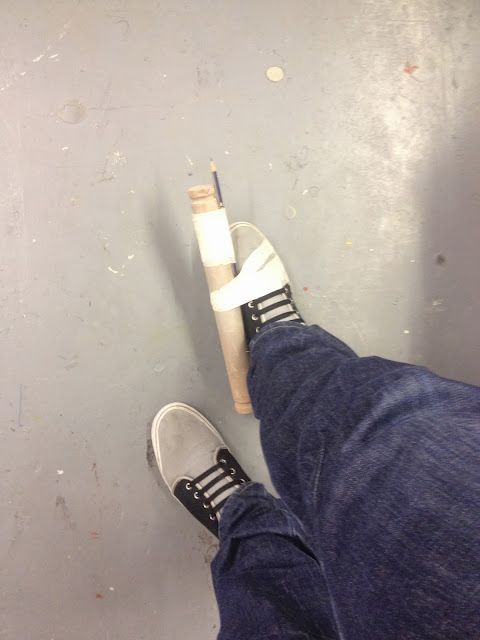The eight paintings in William Hogarth's A Rake's Progress (1733) tell the story of Tom Rakewell, a young man who follows a path of vice and self-destruction after inheriting a fortune from his miserly father. It was Hogarth's second 'modern moral subject', and followed the hugely successful A Harlot's Progress (1730).
The series is principally known through the engravings made by Hogarth from his paintings in 1735. In an advertisement published in November 1734 Hogarth invited potential subscribers to visit his studio in Leicester Fields (now Leicester Square) to see the paintings before subscribing to a set of engravings.
The paintings were in the possession of William Beckford until Soane bought them at auction in 1802 for 570 guineas (Mrs Soane bid for them at Christie's on her husband's behalf). The canvasses of A Harlot's Progress, also owned by Beckford, had been destroyed in a fire at Fonthill Splendens, Wiltshire, in 1755.
The paintings were originally hung at Soane's country villa, Pitzhanger Manor, Ealing, but were moved back to Lincoln's Inn Fields in 1810. In 1824 Soane re-hung them in his new Picture Room at the rear of No.14 Lincoln's Inn Fields together with the recently acquired Election series.
1. The Heir

This scene introduces our hero, Tom Rakewell, who has inherited a fortune following the death of his miserly father. Tom is pictured in his father's house which is beginning to yield up its hoarded wealth.
Tom is attempting to pay-off a servant girl, Sarah Young. She holds a gold ring, revealing that Tom has seduced her with the promise of marriage. Behind Tom, a lawyer, employed to compile an inventory of his dead father's estate, is stealing gold coins. A starved cat searches for food in a chest full of silver, whilst servants find treasure hidden in the fireplace and behind wall hangings.
2. The Levee

The second scene sees Tom in his new palatial lodgings where he is holding a morning levée in the manner of a fashionable gentleman.
Amongst the assorted visitors who have come to offer their services is a jockey, a dancing-master (with violin), a music teacher (believed to be based on Hogarth's great rival Handel), a landscape gardener, a poet and a tailor.
On the wall behind hang some of Tom's recent acquisitions three Italian paintings - Hogarth was known to dislike the fashion for acquiring Old Master works (which he branded 'dark pictures') at the expense of paintings by British artists.
3. The Orgy

It is three o'clock in the morning and Tom, drunk, is enjoying the attentions of prostitutes at the Rose Tavern in London's Covent Garden. A night watchman's staff and lantern lie beside him (souvenirs of a rowdy night in the surrounding streets). Two of the ladies are relieving Tom of his watch.
In the foreground a woman is undressing ready to perform poses on the pewter dish that is being carried into the chamber.
4. The Arrest

Tom has squandered his fortune and narrowly escapes arrest for debt on the way to a party at St James's Palace. It is Queen Caroline's birthday, also St David's Day, and the two bailiffs wear leeks in their hats to mark the occasion.
Tom is saved by Sarah Young, now a milliner, who pays his bail money with her meagre earnings. A street urchin steals Tom's gold-topped cane, whilst a lamplighter, distracted by the commotion, accidentally pours oil on to Tom's wig.
5. The Marriage

Impoverished, but accustomed to a life of luxury and excess, Tom decides to marry an old hag for her fortune. The shabby setting is Marylebone church, which at this time was on the northern fringes of London and well known as a venue for clandestine weddings.
Tom is clearly more interested in the pretty young maid then his one-eyed bride. In the background Sarah Young and her mother are being prevented from entering the church.
Two dogs in the foreground (one of which has lost an eye) present a grotesque parody of the marriage.
6. The Gaming House

Tom, wigless and cursing his fate, has gambled away his second fortune.
The setting is White's Club in Soho. Tom is not the only loser - a dejected highwayman (with pistol and mask protruding from his pocket) sits by the fire, and a nobleman, eager to continue playing, pleads for an advance from a moneylender.
The gamblers are oblivious to the fact that the club is on the point of destruction. Only the two croupiers appear to have noticed the smoke curling in from behind the panelling.
7. The Prison

Tom is now an inmate of the Fleet, London's celebrated debtors' prison. Beside him lies the rejected script of a play he has written in the hope of securing his freedom.
Other prisoners in the cell are trying similarly hopeless schemes. One man has written a treatise on how to pay 'ye Debts of ye Nation', and another is attempting to make 'fools' gold.
Tom, exhibiting the first signs of impending madness, has sunk into despair. The beer-boy harasses him for payment whilst the gaoler demands the settlement of his weekly bill. His wife scolds him for having squandered her fortune.
Sarah Young, who is visiting with her child, has fainted from distress at the scene.
8. The Madhouse

In the concluding scene Tom has descended into madness and is now in Bethlem Hospital or Bedlam as it was known.
He is surrounded by other inmates who are suffering various delusions. These include a tailor, a musician, an astronomer and an archbishop. In the door to one of the cells is a man who thinks he is a king - he is naked and carries a straw crown and sceptre.
Like the real Bedlam, Hogarth's Madhouse is open to the public. Two fashionable ladies have come to observe the poor suffering lunatics as one of the sights of the town.
The ever-faithful Sarah Young sits, weeping, by Tom's side.










































